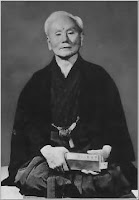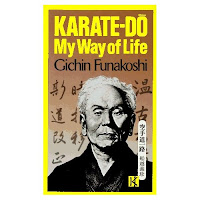Monday, July 23, 2007
Friday, July 13, 2007
Seisan Kata
The kata has over 125 moves, against 13 attackers, and includes 25? punches. (Check facts with Mr. Oliver.) It takes 60 seconds to execute.
It is one of the original kata from the ancient Pangia-Noon style. Its name is derived from Master Seshan. The kata teaches the student how to fight several opponents directly in front of him and how to turn and face opponents coming from different directions. The kata teaches a vertical punch with the thumb on top, instead of the twist punch. It emphasizes the "Seisan Stance" (SHO ZENKUTSU DACHI) of fighting.
Seisan kata is named after master Seisan, a great master from the Pangai Noon Style of Kung Fu. He lived in Okinawa from 1588 to 1600. This was just before the Japanese invasion. He was sent to Okinawa by a Chinese king to teach Chinese boxing. The kata was further developed by the Shorin Ryu system. Some authorities say this is the oldest of all katas. Master Seisan was considered the 8th wonder of the world because of his unusual power and ability.
Master Funakoshi Gichen named the kata Hangetsu (半月) (Japanese: "Half Moon") and adopted it for the Shotokan Style. The name probably came from the sweeping steps. Master Angi Uezu said that the word Seisan means thirteen as if you were defending against thirteen attackers when performing the kata. Seisan is one of the most complete katas and it teaches the basics of Isshinryu Karate. This kata takes years to master.
![]() Here is an old poor quality film (1966) of Master Tatsuo Shimabuku performing the kata.
Here is an old poor quality film (1966) of Master Tatsuo Shimabuku performing the kata.
Joslin's East West Karate—Seisan Kata Facts
- How old is Seisan Kata? Over 400 years old.
- What does Seisan mean? Thirteen
- How many blocks in Seisan Kata? Twenty-four
- What is the weight distribution in Seisan stance? 50/50
- How many kiai in Seisan Kata? Two
- Why is the thumb on top of the Isshinryu fist? Strengthens the wrist
- How many moves are in Seisan Kata? Over 125
- What story does Seisan Kata tell? Breaking focus
- Name the three main benefits of Seisan Kata? Breathing, rapid technique, Seisan stance
- Seisan Kata originally came from which type of karate? Shorinryu
References
- VerticalFist.com
- Sensei Mario Ambris
- wikipedia, historical speculations
- Sensei Brian Winkelman
Tuesday, July 10, 2007
Ichi-go ichi-e
In reading about Kabuki theater I came across the term Ichi-go ichi-e. I have never heard the term ichi-go ichi-e before but it seems to me to encapsulate my ideas about beginner's mind and never doing the same technique twice. Mindfullness of practice leads to sound technique.
Food for thought, and grounds for further research.
Sunday, July 8, 2007
Ginchin Funakoshi's Rules

In the book Karate-Do: My Way Of Life
 by Gichin Funakoshi (1975) there is a chapter called Important Points; Six Rules.
by Gichin Funakoshi (1975) there is a chapter called Important Points; Six Rules.
He lists them 1, 2, 4, 5, and 6. The editor acknowledges that Master Funakoshi didn't include a rule #3, it was unaccountable missing. Researching these rules I discovered a book of his on The Twenty Guiding Principles of Karate-Do  as well as a website dedicated to him with a not dissimilar list of unnumbered rules.
as well as a website dedicated to him with a not dissimilar list of unnumbered rules.
Here is my compilation of Ginchin Funakoshi's Rules for Karate-Do.
1. You must be deadly serious in training.
"Since karate is a martial art, you must practice with the utmost seriousness from the very beginning."
2. Train with both heart and soul without worrying about theory.
"Try to do exactly as you are taught without complaining or quibbling."
"When you are learning a new technique, practice it
wholeheartedly until you truly understand it."
4. Avoid self-conceit and dogmatism.
"Don't pretend to be a great master and don't try to show off your strength."
"Remember that you must always have a deep regard for courtesy, and you must be respectful and obedient toward your seniors."
5. Try to see yourself as you truly are and try to adopt what is meritorious in the work of others.
"You must ignore the bad and adopt the good."
6. Abide by the rules of ethics in your daily life, whether in public or private.
"Think of everyday life as karate training."
Check out this YouTube slideshow of Ginchi Funakoshi and Shotokan Karate-Do.
Friday, July 6, 2007
Test for Shichikyu

Master Dave Joslin tested me for Shichikyu (yellow belt) after Thursday tonight's class. He asked me and Ms. Bloom to do selected kata from the lower body moves.
When doing these examinations the candidate should wait for the instructor to announce the art then signal to begin by counting out the repetitions in Japanese. The candidate echos the count as they demonstrate, alternating right then left side when applicable. In the lower body moves, kicks, one shifts from a right guard to a left guard to demonstrate the left leg kicks; "eesa" is shouted when the feet are switched.
Promotion ceremony will be next Wednesday, July 11th at 6:00 PM.
Thursday, July 5, 2007
Karate-Do: My Way Of Life

Karate-Do: My Way Of Life by Gichin Funakoshi (1975). This is an autobiographical book written by the man generally credited with exposing Japan and the world to Karate-Do, an Okinawain martial art.
The book reads as if you are politely listing to an old man reminiscing about his life, the things he believes are significant. At times I felt that a good editor would have made for a better story structure. Obviously Master Funakoshi is a proud man of exemplary character who has changed the world for the better. I would like to read a biography about him where the context and impact of his actions are illustrated. I imagine that much of what he did naturally had profound impact on his students and the community. However, as we can never know the extent of our own influence it requires a third person to observe and report.
The Karate book I read before this (The Weaponless Warriors) was a history of many karateka that told great stories of challenges, fights and self defense. It gave me the impression that Karate was primarily a fighting art. But Gichin Funakoshi didn't get into any significant scraps, as a mature martial artist he focused on kata and teaching. I suspect that by taking the danger/injury out of the martial art and focusing on the health and defensive nature you broaden the market (most people don't want to get hurt). Thus the domestication of Karate-Do is what, at least in part, led to its rapid assimilation around the world during Funakoshi's lifetime.
One of the passages that was particularly profound to me was a quote from his first book published in 1922, Ryukyu Kempo: Karate.
"Deep within the shadows of human culture lurk seeds of destruction, just as rain and thunder follow in the wake of fair weather. History is the story of the rise and fall of nations. Change is the order of heaven and earth; the sword and the pen are as inseparable as the two wheels of a cart. Thus, a man must encompass both fields if he is to be considered a man of accomplishment. If he is overly complacent, trusting that the fair weather will last forever, he will one day be caught off guard by terrible floods and storms. So it is essential for all of us to prepare each day for any unexpected emergency.
"... Today we are enjoying peace, and our country is making great strides forward in every field. Swords and lances, now virtually useless, have been stored away in our cupboards. But now the subtle art of self-defense called karate grows increasingly popular, and people have asked me time and again whether there is not some good reference book available."


